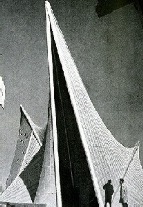|
1 |
 Copyright: Le Memorial officiel de l'Exposition universelle et internationale de Bruxelles 1958-1962, Bd. 4, S. |
|
1 |
 Copyright: Le Memorial officiel de l'Exposition universelle et internationale de Bruxelles 1958-1962, Bd. 4, S. |
The concept for the Philips pavilion presented by world famous architect Le Corbusier rekindled the dream of an all encompassing work of art. From the early twentieth century onwards this idea has often caused creative artists to present overlapping concepts frequently associated with the notion of creating a "new man", and allencompassing utopian societies. To create a symbol for the germinal electronic age, whose innovative technical possibilities would eventually produce a fundamental change in the habits of people's perception and hence their everyday life, Le Corbusier, working in collaboration with Jannis Xenakis, designed an electronic poem for the Netherlands based Philips Electronics Group: a choreography of "light, colour, image, rhythm, sound and architecture". Le Corbusier - painter, theorist, sculptor and architect - developed an unsupported roof design based on hyperbolic parabolas which spanned a concrete plate sunk into the ground. 40 cm thick concrete pillars were arranged cruciformally with different spacings, tensioned with seven millimetres thick iron rings to create a curved and dynamic net-like framework which was skinned with thin concrete slabs. Painted silver the overall impression was that of a light, floating sculpture - its membranous roofs creating the ideal acoustic space for the multimedia spectacle presented in the interior.
The show waived "fabricated objects", using instead electronically transmitted, automated light and sound effects which moved within the room in a synthesis. Visitors passed the control room containing the technical equipment through a tubular entrance zone, entering a hall with an organic, stomach shaped plan into which up to 500 persons could be simultaneously immersed in a magical world. Celestial sounds, compositions by Edgar Varèse, films projected on panoramic screens and abstract coloured lighting effects in an eight minute electronic poem which used state-of-the-art electronic media to generate a visionary retelling of the story of human development.
| Year: 1958 | City: Brussels | Country: Belgium |
| Duration: 17th April - 19 October 1958 | ||